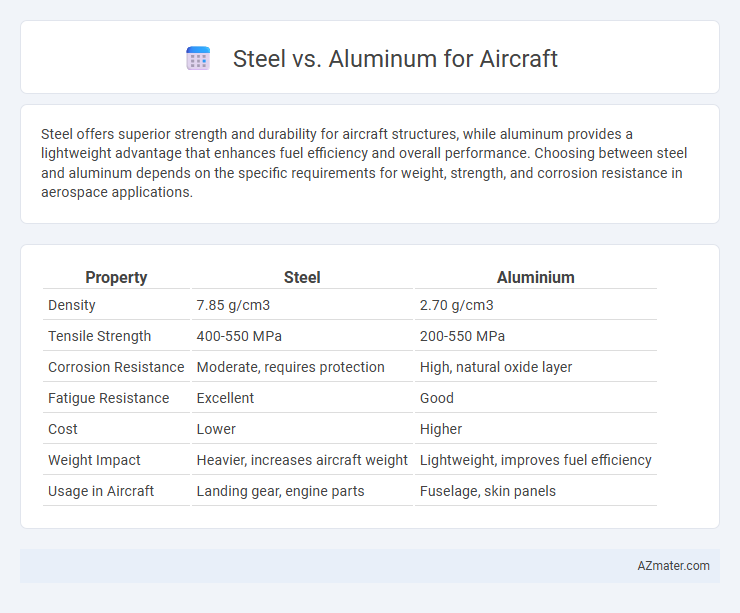Steel offers superior strength and durability for aircraft structures, while aluminum provides a lightweight advantage that enhances fuel efficiency and overall performance. Choosing between steel and aluminum depends on the specific requirements for weight, strength, and corrosion resistance in aerospace applications.
Table of Comparison
| Property | Steel | Aluminium |
|---|---|---|
| Density | 7.85 g/cm3 | 2.70 g/cm3 |
| Tensile Strength | 400-550 MPa | 200-550 MPa |
| Corrosion Resistance | Moderate, requires protection | High, natural oxide layer |
| Fatigue Resistance | Excellent | Good |
| Cost | Lower | Higher |
| Weight Impact | Heavier, increases aircraft weight | Lightweight, improves fuel efficiency |
| Usage in Aircraft | Landing gear, engine parts | Fuselage, skin panels |
Introduction to Aircraft Material Choices
Aircraft material choices significantly impact performance, weight, and durability, with steel and aluminium being primary contenders. Steel offers high tensile strength and fatigue resistance, making it ideal for load-bearing components, while aluminium provides lightweight properties essential for fuel efficiency and speed. Understanding the balance between steel's robustness and aluminium's lightness informs decisions in aerospace engineering for optimal aircraft design.
Mechanical Properties: Steel vs Aluminium
Steel offers superior tensile strength and hardness compared to aluminium, making it ideal for structural components requiring high load-bearing capacity in aircraft. Aluminium excels in strength-to-weight ratio and corrosion resistance, significantly reducing overall aircraft weight while maintaining durability. The choice between steel and aluminium hinges on balancing mechanical strength requirements with weight constraints to optimize aircraft performance.
Weight Comparison and Efficiency
Steel offers higher strength but is significantly denser, often weighing nearly three times more than aluminum for the same volume, leading to increased aircraft weight. Aluminum's lightweight properties contribute to better fuel efficiency and improved payload capacity, making it the preferred choice for most aircraft structures. The weight reduction achieved by using aluminum enhances overall flight performance, reducing operational costs and emissions.
Corrosion Resistance and Durability
Aluminium offers superior corrosion resistance compared to steel, making it ideal for aircraft exposed to varying atmospheric conditions and reducing maintenance costs. Steel provides higher tensile strength and durability under mechanical stress but requires protective coatings to prevent rust and corrosion. The choice between steel and aluminium in aircraft structures hinges on balancing aluminium's lightweight, corrosion-resistant properties against steel's robustness and durability.
Cost Analysis: Initial and Lifecycle
Steel offers greater strength and durability for aircraft components but comes with higher initial manufacturing costs due to its weight and machining complexity. Aluminium, widely favored for its lightweight properties, reduces fuel consumption and maintenance expenses, leading to lower lifecycle costs despite slightly higher initial alloy expenses. Lifecycle cost analysis highlights aluminium's advantage in fuel savings and corrosion resistance, making it the more cost-effective choice for long-term aircraft operations.
Manufacturing and Fabrication Considerations
Steel offers superior strength and durability for aircraft manufacturing but requires more energy-intensive fabrication processes due to its higher melting point and weight, affecting overall production efficiency. Aluminium is favored for its lightweight properties and ease of machining, enabling faster fabrication and reduced tooling wear, which lowers manufacturing costs and production time. Corrosion resistance and fatigue performance also influence material choice, with aluminium alloys commonly used to optimize aircraft structural integrity while maintaining manufacturability.
Performance in Extreme Conditions
Steel demonstrates exceptional strength and durability under extreme temperature fluctuations and high stress, making it ideal for structural components in harsh aerospace environments. Aluminium offers superior corrosion resistance and lightweight properties, enhancing fuel efficiency and maneuverability but may require protective coatings to withstand severe weather or corrosive atmospheres. Selecting between steel and aluminium depends on balancing the need for tensile strength and weight reduction in aerospace engineering to optimize performance in extreme conditions.
Environmental Impact and Sustainability
Steel and aluminum differ significantly in environmental impact and sustainability within aircraft manufacturing; aluminum offers lower weight, which improves fuel efficiency and reduces carbon emissions during aircraft operation. However, aluminum production involves high energy consumption and greenhouse gas emissions, whereas steel recycling processes are more energy-efficient and widely established, contributing to a circular economy. Lifecycle assessments indicate that aluminum's lightweight benefits often outweigh its production footprint, but sustainable sourcing and advances in steel alloys may shift future preferences in aerospace materials.
Common Applications in Aircraft Parts
Steel is predominantly used in aircraft parts requiring high strength and durability, such as landing gear, engine mounts, and fasteners, where its superior tensile strength and fatigue resistance are critical. Aluminium alloys are favored for fuselage skin, wing structures, and interior components due to their lightweight properties and excellent corrosion resistance, contributing to overall fuel efficiency and performance. Titanium and composite materials often complement steel and aluminium in modern aircraft design for optimal strength-to-weight ratios and structural integrity.
Future Trends in Aircraft Material Selection
Future trends in aircraft material selection emphasize lightweight composites and advanced aluminum-lithium alloys over traditional steel due to superior strength-to-weight ratios and corrosion resistance. Innovations in nanotechnology and additive manufacturing are enhancing aluminum's fatigue performance and manufacturability, positioning it as a key material for next-generation aircraft. Sustainable aviation goals drive materials research towards recyclability and reduced lifecycle emissions, favoring aluminum and composite integration in future airframe designs.

Infographic: Steel vs Aluminium for Aircraft
 azmater.com
azmater.com